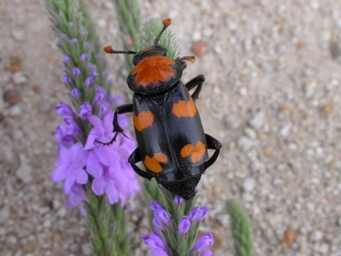Endangered species feature: family life of the American burying beetle
Michigan Department of Natural Resources sent this bulletin at 07/09/2014 04:43 PM EDT|
Learn about the fascinating life of this beetle that no longer exists in Michigan. |
 |
 |
 |
 |
 |
Wildlife Viewing
Threatened and endangered species feature: family life of the American burying beetle
July 9, 2014
 Through generous support from DTE Energy, the DNR is celebrating the 40th anniversary of Michigan’s Endangered Species Act from now through September. Each week, an important species will be featured.
Through generous support from DTE Energy, the DNR is celebrating the 40th anniversary of Michigan’s Endangered Species Act from now through September. Each week, an important species will be featured.
Alfred Tennyson captured the idea well in his poem Locksely Hall: “In the spring, a young man's fancy lightly turns to thoughts of love.” It is the story of many animals. Spring means finding or building a shelter. Having kids. Feeding them. Protecting them from harm. The birds and the beetles. Yes, beetles. The American burying beetle is one of the few insects to build a nest and care for its young.
 American burying beetles are also one of the few insects to form durable monogamous relationships. They mate for life. Granted, it is a short life, as they only live for a year. In the spring the young male beetle begins to search for the perfect place to raise his offspring. The three most important aspects he looks for are location, location and location. When he finds the perfect place (a freshly dead animal the size of a large pigeon), he calls his mate using pheromones, a chemical signal, which attracts her and any other burying beetle pairs in the carrion real-estate market. A bidding war ensues. Actually, it is closer to a real war. (Interestingly, American burying beetles do show some level of civilization. Gentlemen beetles will not strike a lady, nor will a lady beetle strike a gentleman.) Once property rights are firmly established, the pair then buries the dead animal in a sort of underground cellar. They secrete preservatives to keep the meat from decaying, and then the female lays eggs. After hatching, the young can feed themselves, but they often beg the parents to feed them regurgitated meat, much like many predatory birds. The parents protect their offspring from ants, flies and other beetles. Weeks later, the young beetles leave the nest, and the cycle begins again the next spring, when more young beetles’ fancy again turns to thoughts of love.
American burying beetles are also one of the few insects to form durable monogamous relationships. They mate for life. Granted, it is a short life, as they only live for a year. In the spring the young male beetle begins to search for the perfect place to raise his offspring. The three most important aspects he looks for are location, location and location. When he finds the perfect place (a freshly dead animal the size of a large pigeon), he calls his mate using pheromones, a chemical signal, which attracts her and any other burying beetle pairs in the carrion real-estate market. A bidding war ensues. Actually, it is closer to a real war. (Interestingly, American burying beetles do show some level of civilization. Gentlemen beetles will not strike a lady, nor will a lady beetle strike a gentleman.) Once property rights are firmly established, the pair then buries the dead animal in a sort of underground cellar. They secrete preservatives to keep the meat from decaying, and then the female lays eggs. After hatching, the young can feed themselves, but they often beg the parents to feed them regurgitated meat, much like many predatory birds. The parents protect their offspring from ants, flies and other beetles. Weeks later, the young beetles leave the nest, and the cycle begins again the next spring, when more young beetles’ fancy again turns to thoughts of love.
But not in Michigan – not anymore. Although they were once found across both peninsulas, the last confirmed sighting of an American burying beetle in Michigan was in 1961 in Kalamazoo County. Michigan has other, smaller species of burying beetles, but the 1-inch-long American burying beetle has been extirpated from this state. Indeed, they have disappeared from most of their historic range and are listed on the federal Endangered Species List as threatened.
The reason for their disappearance is a bit of a mystery. The timing does not fit for pesticide contamination, such as DDT. Loss of habitat has also been hypothesized, but existing burying beetle populations use many different habitats. It might have been a disease, but beetle disease is a woefully understudied, and underappreciated, field of knowledge. If you want to be the world expert on something, studying beetle diseases might be a great option.
The two best explanations for the disappearance of American burying beetles from Michigan and most other states are loss of abundant prey of the proper size and competition with other scavengers. It is a tough real estate market for American burying beetles looking for fresh dead animals large enough for a family of 10-20 kids. Once there were nice big houses on comfortable-sized lots everywhere, and the only competition was other smaller burying beetle species. Those were the good times. Then all the big houses disappeared.
The “big houses” were passenger pigeons. Up until about 100 years ago, passenger pigeons were the most common bird in the world, numbering in the billions. Indeed, flocks of passenger pigeons miles wide and hundreds of miles long would darken the sun for days. Nesting colonies of passenger pigeons were described in terms of counties, where the sheer weight of nests would strip trees of limbs, or topple trees altogether. The number of passenger pigeons alive then cannot be imagined, let alone exaggerated. How many carcasses would have been available? In a stable population, as many animals are born as die in a given year. If the pigeons laid a billion eggs per year, roughly the same number of birds would have died each year, assuming their populations were stable. One billion perfectly sized houses for the beetles. The geographic range of the two species overlapped almost exactly.
Now the passenger pigeons are gone. There are no freshly dead passenger pigeons. All that remains are houses too small on lots too small. (And city pigeons on cement sidewalks, which are not suitable for burial.) Imagine a world in which all the houses and apartments with more than one bedroom suddenly disappeared over the course of a decade. It would be tough to find a place to raise a family.
Add to that the fact that Michigan has never had so many scavengers: raccoons, opossums, skunks and crows. All the scavengers thrive in a world of trash bags, dumps and litter. When they cannot find trash, scavengers will eat carrion. For the burying beetles, the much-reduced housing market is now awash in hungry new competition.
Burying beetles are fascinating, which is reason enough to be concerned about their conservation. But they also provide valuable services to humans. The chemicals that they use to preserve meat are being studied to increase food safety. Burying beetles also are able to destroy rabies, a disease that is almost 100-percent fatal to humans. And they help clean up nature without some of the mess, odor and damage caused by other scavengers.
While the American burying beetle is still absent from Michigan, it has been reintroduced to Ohio. Perhaps someday it will return to Michigan. Until then, you can help all burying beetles by not littering and by picking up litter when you see it. Support policies that result in place-making and smart development: vibrant cities surrounded by large blocks of agriculture and large blocks of nature. The way we choose where to live, individually and as a society, affects the real estate market for wildlife from the American crow down to that most family-oriented of all insects: the American burying beetle.
For more information on Michigan's threatened and endangered species and the 40th-anniversary celebration, visit www.michigan.gov/wildlife.
American burying Beetle photo courtesy of Doug Backland.